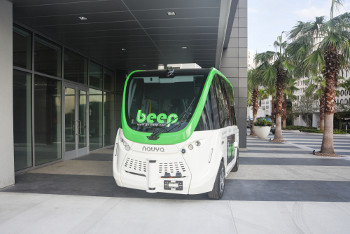Last month the Law Commissions of England and Wales and of Scotland published a consultation on regulating Highly Automated Road Passenger Services (HARPS).
Transport Network spoke to Dr Wolfgang Schuster, technical director - transportation, UK and Europe at Atkins, about the issues the paper raises.
Do you agree with the Commissions’ three tier model of assisted driving; highly automated driving with a user-in-charge; and highly automated driving?

Wolfgang Schuster
I think if we go back to the original six SAE levels (including Level 0), there was a lot of confusion from a number of stakeholders, including drivers, as to what those levels actually meant for example in terms of their responsibilities, with some drivers for example being under the impression that at Level 4 they could simply let go of the steering wheel.
We know that there is a challenge when you don’t know what your responsibility is, with potential safety implications. So simplifying that model is a good step in the right direction, because it will make it simpler to understand your responsibilities when you have only three categories.
One of the key discussions in the past was around level 3 for example, which was one of the more challenging ones. There was discussion around whether that should be scrapped altogether because it provides for too much confusion as to who was in charge and when. And we’ve studied this as part of the Venturer project which Atkins was leading, we’ve studied the impact of the handover between system and human driven modes. Sometimes the time for the handover between when the system tells you ‘you need to take over’ and the driver actually taking over can be a long time with potential safety implications.
So on the basis of that, when you have a vehicle that is not fully autonomous it is important that the drivers are aware that they are always in charge. That’s the only way that we can maintain safety levels and by simplifying these levels, I think the Law Commissions have gone in the right direction basically by making it easier for the different stakeholders to understand what their various responsibilities are – what they can do and what they can’t do.
In relation to HARPS, what do you think is the biggest potential benefit of having passenger vehicles that can come without a driver and take you where you want to go?
I think there are many different stakeholders, so when you look at the Atkins-led Flourish project for example, which I was Chair of, we focused on older people and those with mobility-related conditions, because we expect those people to be early adopters of the technology due to the immediate tangible benefits it can provide. Our focus on older people also addresses the industrial strategy grand challenges, including the need to address the challenges associated with an ageing population and the need to enhance mobility and create a much more inclusive environment.
While we focused on older people, there are clearly benefits for wider society. The fact that these autonomous vehicles don’t need to be stationary at the origin or at the destination of journeys for very long, that has implications in terms of city planning, for example because you don’t need as much parking.
One of the things that the Law Commissions have pointed out is that you could reallocate parking space, perhaps roadside parking space. On the other hand, there is the issue of cruising – vehicles cruising around the streets because they don’t want to pay for parking. In a regulatory framework, what do you think is the best way to address the issue of cruising?
First of all we need to look very carefully at the commercial models, because there is a tight interlink between the operational models and the commercial models. The ideal scenario would be that at any point in time, if there is enough demand, these vehicles will serve their purpose – in other words to transport passengers; commercially it wouldn’t be interesting for these vehicles to cruise for the sake of cruising.
If a vehicle drives me from A to B (and hopefully I’m going to share that journey with someone else), when I arrive at my destination the vehicle will already have received its next request to bring someone else from C to D. So there should be, in an ideal world, continuity, a system which is in some form or other centrally managed to really optimise the usage of these vehicles, because that is the only way in which we can reduce the number of vehicles on our roads, for a given demand.
What do you think is the biggest risk or threat that these vehicles could produce, perhaps in terms of adding to congestion?
First of all let’s note that the upsides clearly far outweigh the potential downsides. A lot of the downsides can be eliminated by putting in place appropriate commercial models and regulatory frameworks. Let’s say everyone, because private transport and connected and autonomous vehicles become very accessible and very cheap to use, everyone wants to use them, very quickly we would end up with increasing congestion and we’ve seen that effect already in London through what some people call the Uber effect.

A driverless autonomous passenger vehicle in Lake Nona Florida
Regulation will be crucial, for example to set a minimum price cap, which could incentivise use of public transport, over private transport. At the same time we can’t overregulate either because we don’t want to stifle innovation. So a fine balance will need to be struck.
Another issue that needs to be focused on, which is receiving a lot of attention currently, is the security of these vehicles. This is a very important point because these vehicles will be connected with infrastructure and other technologies outside the vehicle.
They may well link in with your smart fridge at home for example. There’s a core challenge here around how you align security requirements across all relevant stakeholders, some of whom may have much less of an incentive to address security challenges. Flourish was involved in addressing some of those cybersecurity challenges. Atkins was involved in developing an understanding of the threat and vulnerability landscape and also looking at what responses we can provide to ensure that these vehicles will be absolutely safe and secure in the case of an incident.
We have developed an incident response framework and built on that for our Human Drive project to develop an incident response plan that will be used for the first fully autonomous drive in the UK across different types of roads and road configurations typical of end-to-end journeys through live traffic later this year. Atkins is providing an incident response plan which is looking at all the eventualities for what could go wrong, to prevent incidents from occurring in the first place and to ensure appropriate mitigation is always in place, to ensure that the vehicle and other road users are ultimately safe.
Register now for full access
Register just once to get unrestricted, real-time coverage of the issues and challenges facing UK transport and highways engineers.
Full website content includes the latest news, exclusive commentary from leading industry figures and detailed topical analysis of the highways, transportation, environment and place-shaping sectors.
Use the link below to register your details for full, free access.
Already a registered? Login